Abstract
Rhinoviruses can survive on environmental surfaces for several hours under ambient conditions. Hands can readily become contaminated after contact with such surfaces, and self-inoculation may lead to infection. Whereas hand washing is crucial in preventing the spread of rhinovirus colds, proper disinfection of environmental surfaces may further reduce rhinovirus transmission. In this study, the capacities of Lysol Disinfectant Spray (0.1% o-phenylphenol and 79% ethanol), a domestic bleach (6% sodium hypochlorite diluted to give 800 ppm of free chlorine), a quaternary ammonium-based product (7.05% quaternary ammonium diluted 1:128 in tap water), and a phenol-based product (14.7% phenol diluted 1:256 in tap water) were compared in interrupting the transfer of rhinovirus type 14 from stainless steel disks to fingerpads of human volunteers upon a 10-s contact at a pressure of 1 kg/cm2. Ten microliters of the virus, suspended in bovine mucin (5 mg/ml), was placed on each disk, and the inoculum was dried under ambient conditions; the input number on each disk ranged from 0.5 x 10(5) to 2.1 x 10(6) PFU. The dried virus was exposed to 20 microliters of the test disinfectant. The Lysol spray was able to reduce virus infectivity by > 99.99% after a contact of either 1 or 10 min, and no detectable virus was transferred to fingerpads from Lysol-treated disks. The bleach (800 ppm of free chlorine) reduced the virus titer by 99.7% after a contact time of 10 min, and again no virus was transferred from the disks treated with it.(ABSTRACT TRUNCATED AT 250 WORDS)
Full text
PDF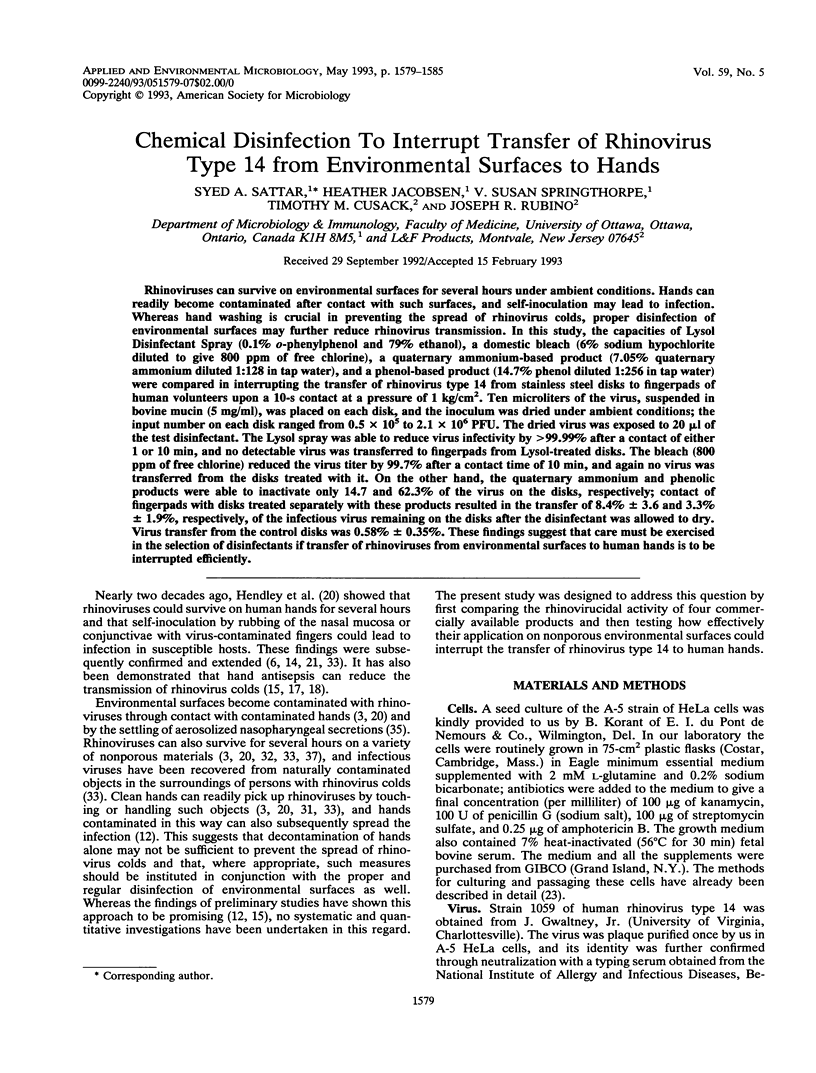
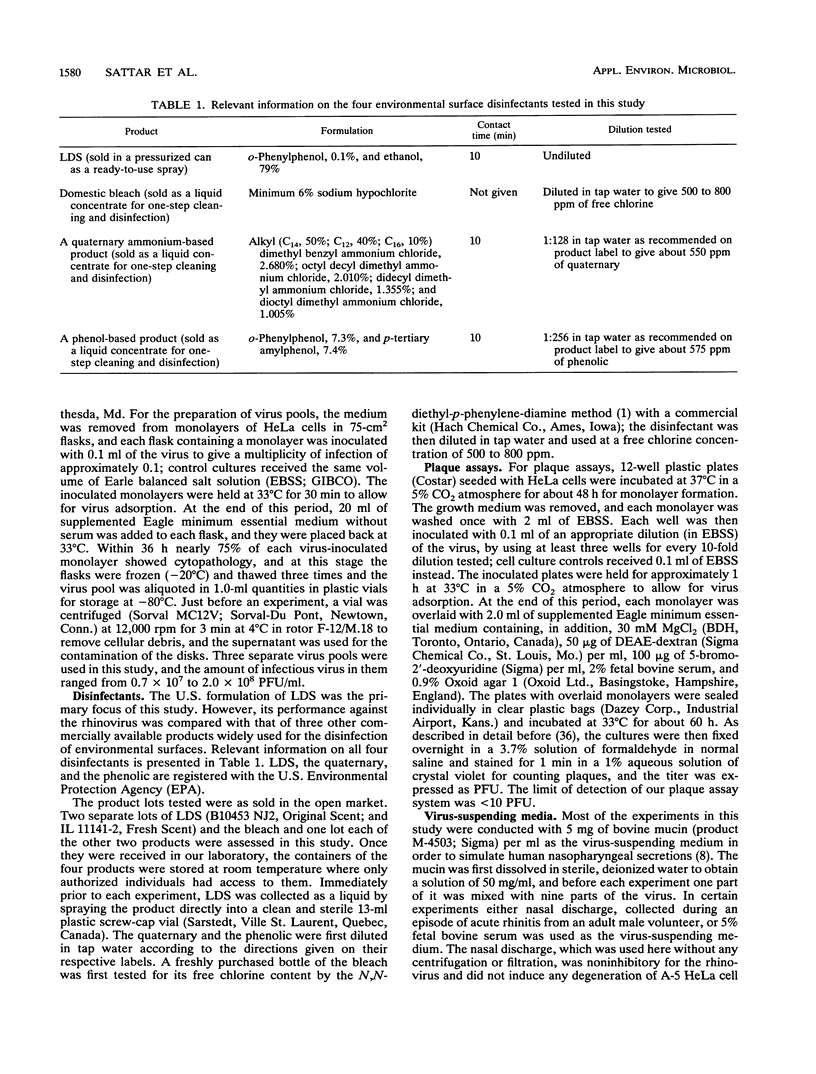
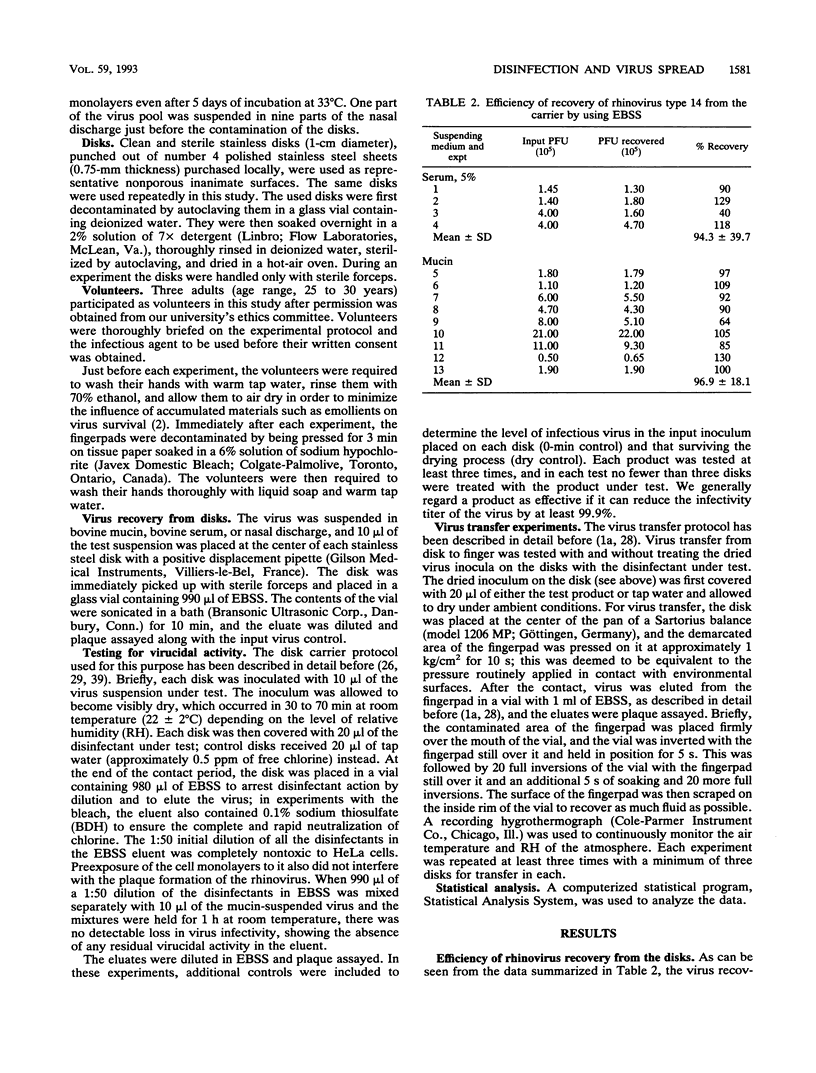
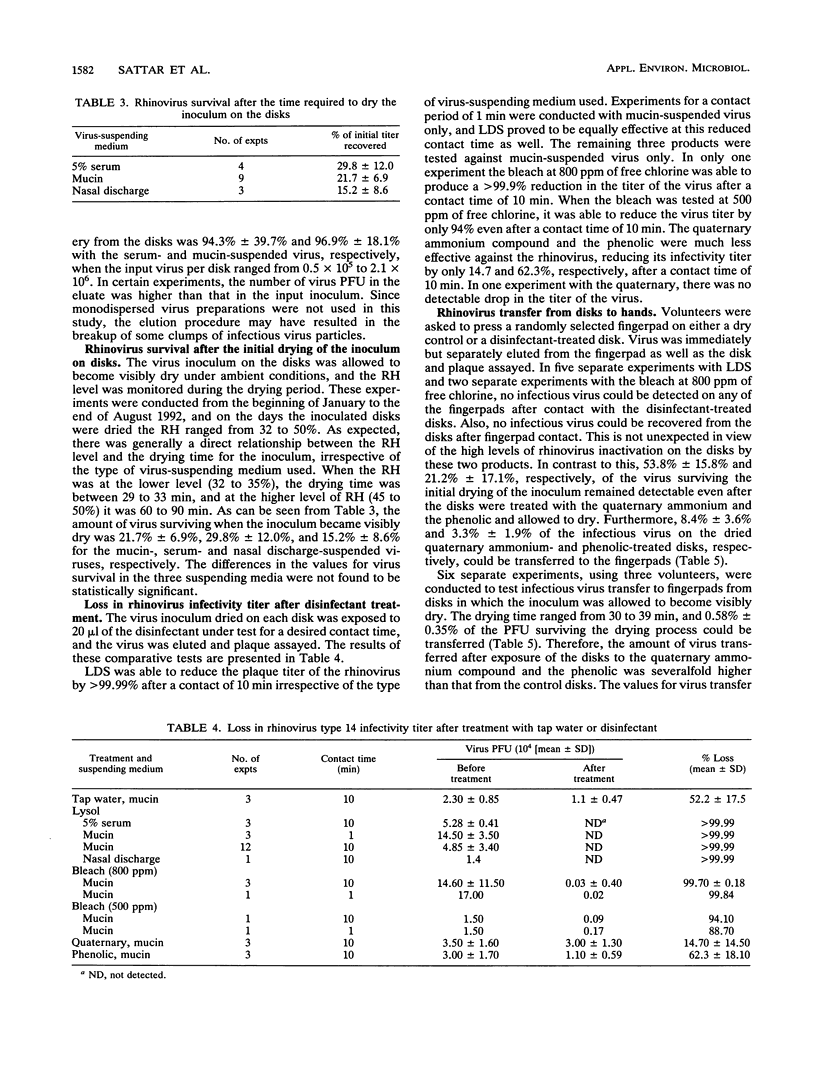
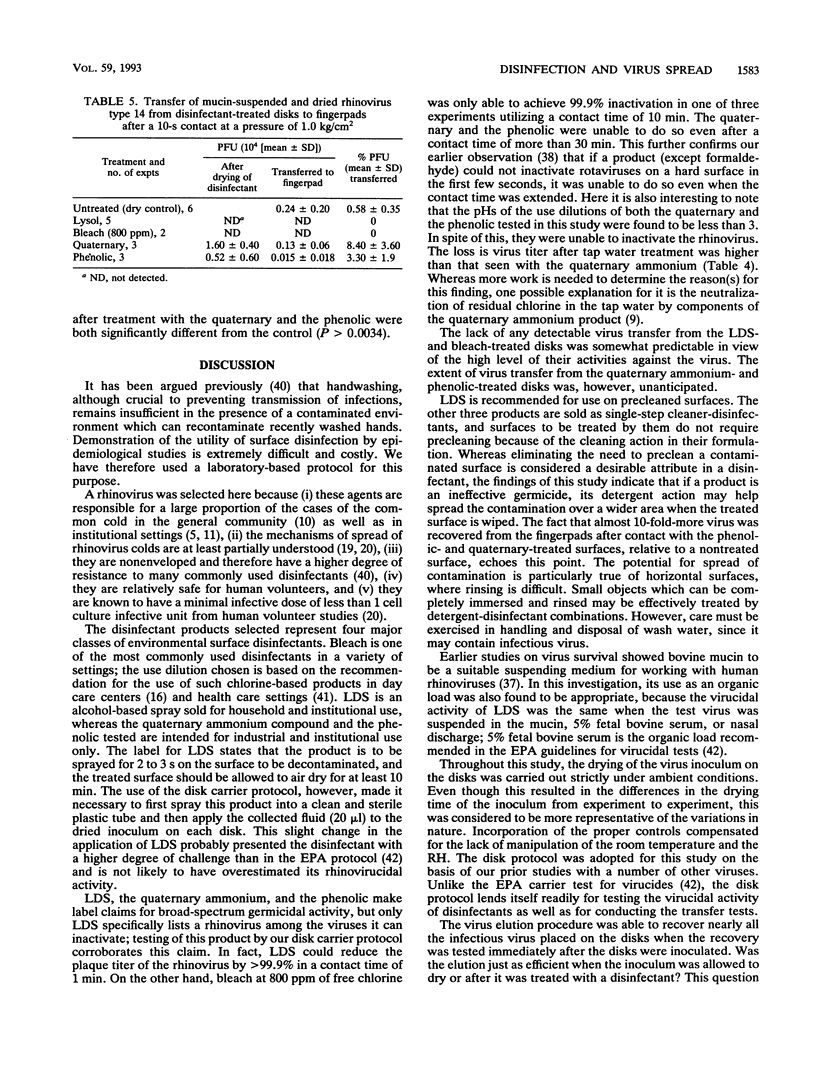
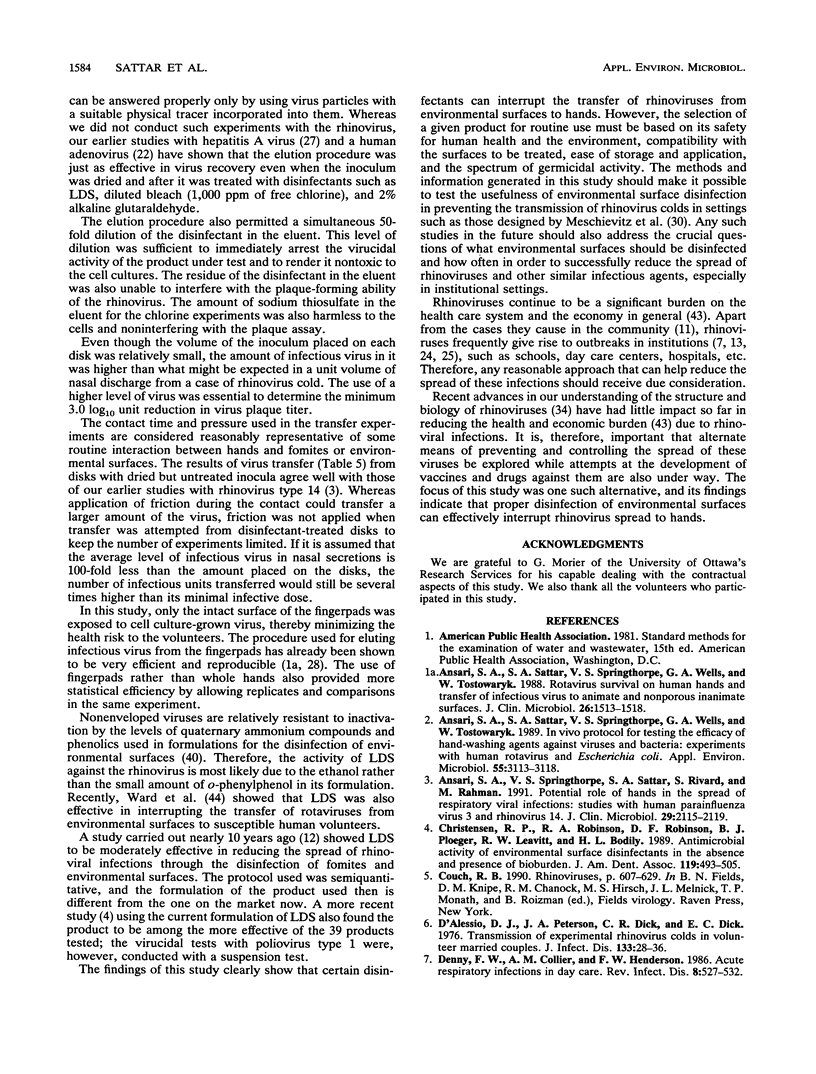
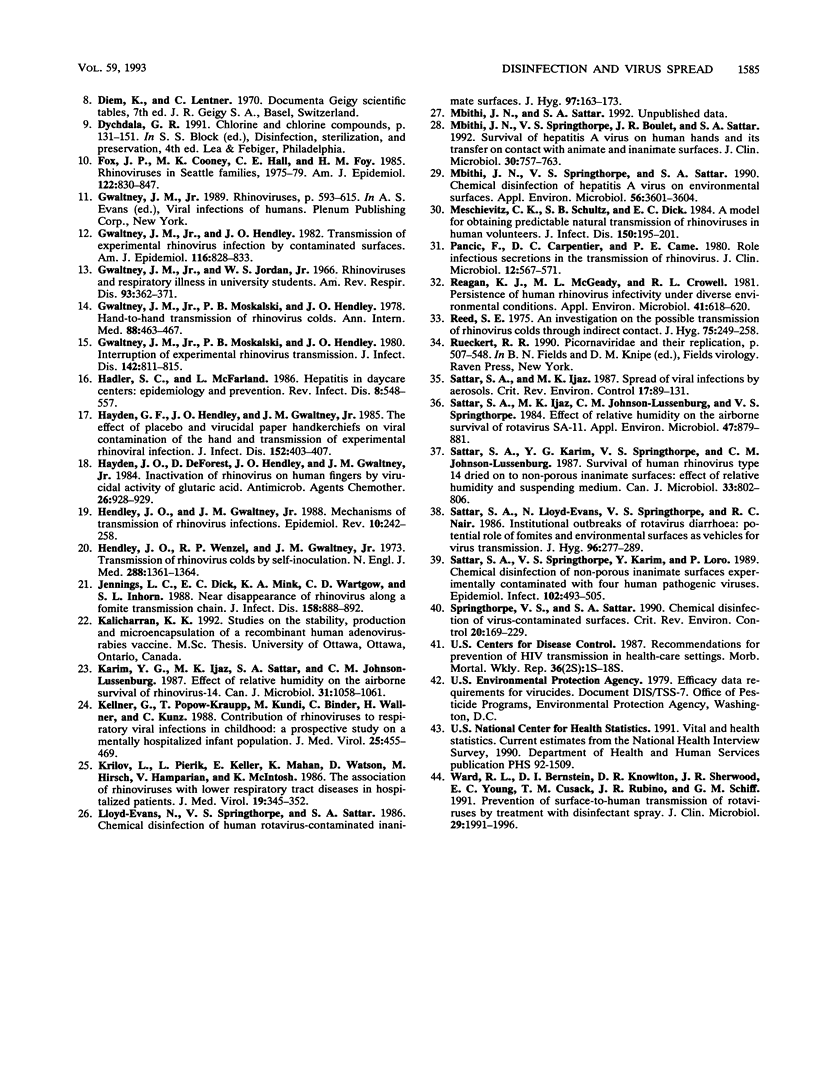
Selected References
These references are in PubMed. This may not be the complete list of references from this article.
- Ansari S. A., Sattar S. A., Springthorpe V. S., Wells G. A., Tostowaryk W. In vivo protocol for testing efficacy of hand-washing agents against viruses and bacteria: experiments with rotavirus and Escherichia coli. Appl Environ Microbiol. 1989 Dec;55(12):3113–3118. doi: 10.1128/aem.55.12.3113-3118.1989. [DOI] [PMC free article] [PubMed] [Google Scholar]
- Ansari S. A., Sattar S. A., Springthorpe V. S., Wells G. A., Tostowaryk W. Rotavirus survival on human hands and transfer of infectious virus to animate and nonporous inanimate surfaces. J Clin Microbiol. 1988 Aug;26(8):1513–1518. doi: 10.1128/jcm.26.8.1513-1518.1988. [DOI] [PMC free article] [PubMed] [Google Scholar]
- Ansari S. A., Springthorpe V. S., Sattar S. A., Rivard S., Rahman M. Potential role of hands in the spread of respiratory viral infections: studies with human parainfluenza virus 3 and rhinovirus 14. J Clin Microbiol. 1991 Oct;29(10):2115–2119. doi: 10.1128/jcm.29.10.2115-2119.1991. [DOI] [PMC free article] [PubMed] [Google Scholar]
- Christensen R. P., Robison R. A., Robinson D. F., Ploeger B. J., Leavitt R. W., Bodily H. L. Antimicrobial activity of environmental surface disinfectants in the absence and presence of bioburden. J Am Dent Assoc. 1989 Oct;119(4):493–505. doi: 10.1016/s0002-8177(89)94006-3. [DOI] [PubMed] [Google Scholar]
- D'Alessio D. J., Peterson J. A., Dick C. R., Dick E. C. Transmission of experimental rhinovirus colds in volunteer married couples. J Infect Dis. 1976 Jan;133(1):28–36. doi: 10.1093/infdis/133.1.28. [DOI] [PubMed] [Google Scholar]
- Denny F. W., Collier A. M., Henderson F. W. Acute respiratory infections in day care. Rev Infect Dis. 1986 Jul-Aug;8(4):527–532. doi: 10.1093/clinids/8.4.524. [DOI] [PubMed] [Google Scholar]
- Fox J. P., Cooney M. K., Hall C. E., Foy H. M. Rhinoviruses in Seattle families, 1975-1979. Am J Epidemiol. 1985 Nov;122(5):830–846. doi: 10.1093/oxfordjournals.aje.a114166. [DOI] [PubMed] [Google Scholar]
- Gwaltney J. M., Jr, Hendley J. O. Transmission of experimental rhinovirus infection by contaminated surfaces. Am J Epidemiol. 1982 Nov;116(5):828–833. doi: 10.1093/oxfordjournals.aje.a113473. [DOI] [PubMed] [Google Scholar]
- Gwaltney J. M., Jr, Moskalski P. B., Hendley J. O. Hand-to-hand transmission of rhinovirus colds. Ann Intern Med. 1978 Apr;88(4):463–467. doi: 10.7326/0003-4819-88-4-463. [DOI] [PubMed] [Google Scholar]
- Gwaltney J. M., Jr, Moskalski P. B., Hendley J. O. Interruption of experimental rhinovirus transmission. J Infect Dis. 1980 Dec;142(6):811–815. doi: 10.1093/infdis/142.6.811. [DOI] [PubMed] [Google Scholar]
- Hadler S. C., McFarland L. Hepatitis in day care centers: epidemiology and prevention. Rev Infect Dis. 1986 Jul-Aug;8(4):548–557. doi: 10.1093/clinids/8.4.548. [DOI] [PubMed] [Google Scholar]
- Hayden G. F., Deforest D., Hendley J. O., Gwaltney J. M., Jr Inactivation of rhinovirus on human fingers by virucidal activity of glutaric acid. Antimicrob Agents Chemother. 1984 Dec;26(6):928–929. doi: 10.1128/aac.26.6.928. [DOI] [PMC free article] [PubMed] [Google Scholar]
- Hayden G. F., Hendley J. O., Gwaltney J. M., Jr The effect of placebo and virucidal paper handkerchiefs on viral contamination of the hand and transmission of experimental rhinoviral infection. J Infect Dis. 1985 Aug;152(2):403–407. doi: 10.1093/infdis/152.2.403. [DOI] [PubMed] [Google Scholar]
- Hendley J. O., Gwaltney J. M., Jr Mechanisms of transmission of rhinovirus infections. Epidemiol Rev. 1988;10:243–258. [PubMed] [Google Scholar]
- Hendley J. O., Wenzel R. P., Gwaltney J. M., Jr Transmission of rhinovirus colds by self-inoculation. N Engl J Med. 1973 Jun 28;288(26):1361–1364. doi: 10.1056/NEJM197306282882601. [DOI] [PubMed] [Google Scholar]
- Jennings L. C., Dick E. C., Mink K. A., Wartgow C. D., Inhorn S. L. Near disappearance of rhinovirus along a fomite transmission chain. J Infect Dis. 1988 Oct;158(4):888–892. doi: 10.1093/infdis/158.4.888. [DOI] [PubMed] [Google Scholar]
- Karim Y. G., Ijaz M. K., Sattar S. A., Johnson-Lussenburg C. M. Effect of relative humidity on the airborne survival of rhinovirus-14. Can J Microbiol. 1985 Nov;31(11):1058–1061. doi: 10.1139/m85-199. [DOI] [PubMed] [Google Scholar]
- Kellner G., Popow-Kraupp T., Kundi M., Binder C., Wallner H., Kunz C. Contribution of rhinoviruses to respiratory viral infections in childhood: a prospective study in a mainly hospitalized infant population. J Med Virol. 1988 Aug;25(4):455–469. doi: 10.1002/jmv.1890250409. [DOI] [PubMed] [Google Scholar]
- Krilov L., Pierik L., Keller E., Mahan K., Watson D., Hirsch M., Hamparian V., McIntosh K. The association of rhinoviruses with lower respiratory tract disease in hospitalized patients. J Med Virol. 1986 Aug;19(4):345–352. doi: 10.1002/jmv.1890190407. [DOI] [PubMed] [Google Scholar]
- Lloyd-Evans N., Springthorpe V. S., Sattar S. A. Chemical disinfection of human rotavirus-contaminated inanimate surfaces. J Hyg (Lond) 1986 Aug;97(1):163–173. doi: 10.1017/s0022172400064445. [DOI] [PMC free article] [PubMed] [Google Scholar]
- Mbithi J. N., Springthorpe V. S., Boulet J. R., Sattar S. A. Survival of hepatitis A virus on human hands and its transfer on contact with animate and inanimate surfaces. J Clin Microbiol. 1992 Apr;30(4):757–763. doi: 10.1128/jcm.30.4.757-763.1992. [DOI] [PMC free article] [PubMed] [Google Scholar]
- Mbithi J. N., Springthorpe V. S., Sattar S. A. Chemical disinfection of hepatitis A virus on environmental surfaces. Appl Environ Microbiol. 1990 Nov;56(11):3601–3604. doi: 10.1128/aem.56.11.3601-3604.1990. [DOI] [PMC free article] [PubMed] [Google Scholar]
- Meschievitz C. K., Schultz S. B., Dick E. C. A model for obtaining predictable natural transmission of rhinoviruses in human volunteers. J Infect Dis. 1984 Aug;150(2):195–201. doi: 10.1093/infdis/150.2.195. [DOI] [PubMed] [Google Scholar]
- Pancic F., Carpentier D. C., Came P. E. Role of infectious secretions in the transmission of rhinovirus. J Clin Microbiol. 1980 Oct;12(4):567–571. doi: 10.1128/jcm.12.4.567-571.1980. [DOI] [PMC free article] [PubMed] [Google Scholar]
- Reagan K. J., McGeady M. L., Crowell R. L. Persistence of human rhinovirus infectivity under diverse environmental conditions. Appl Environ Microbiol. 1981 Mar;41(3):618–620. doi: 10.1128/aem.41.3.618-620.1981. [DOI] [PMC free article] [PubMed] [Google Scholar]
- Reed S. E. An investigation of the possible transmission of Rhinovirus colds through indirect contact. J Hyg (Lond) 1975 Oct;75(2):249–258. doi: 10.1017/s0022172400047288. [DOI] [PMC free article] [PubMed] [Google Scholar]
- Sattar S. A., Ijaz M. K., Johnson-Lussenburg C. M., Springthorpe V. S. Effect of relative humidity on the airborne survival of rotavirus SA11. Appl Environ Microbiol. 1984 Apr;47(4):879–881. doi: 10.1128/aem.47.4.879-881.1984. [DOI] [PMC free article] [PubMed] [Google Scholar]
- Sattar S. A., Karim Y. G., Springthorpe V. S., Johnson-Lussenburg C. M. Survival of human rhinovirus type 14 dried onto nonporous inanimate surfaces: effect of relative humidity and suspending medium. Can J Microbiol. 1987 Sep;33(9):802–806. doi: 10.1139/m87-136. [DOI] [PubMed] [Google Scholar]
- Sattar S. A., Lloyd-Evans N., Springthorpe V. S., Nair R. C. Institutional outbreaks of rotavirus diarrhoea: potential role of fomites and environmental surfaces as vehicles for virus transmission. J Hyg (Lond) 1986 Apr;96(2):277–289. doi: 10.1017/s0022172400066055. [DOI] [PMC free article] [PubMed] [Google Scholar]
- Sattar S. A., Springthorpe V. S., Karim Y., Loro P. Chemical disinfection of non-porous inanimate surfaces experimentally contaminated with four human pathogenic viruses. Epidemiol Infect. 1989 Jun;102(3):493–505. doi: 10.1017/s0950268800030211. [DOI] [PMC free article] [PubMed] [Google Scholar]
- Ward R. L., Bernstein D. I., Knowlton D. R., Sherwood J. R., Young E. C., Cusack T. M., Rubino J. R., Schiff G. M. Prevention of surface-to-human transmission of rotaviruses by treatment with disinfectant spray. J Clin Microbiol. 1991 Sep;29(9):1991–1996. doi: 10.1128/jcm.29.9.1991-1996.1991. [DOI] [PMC free article] [PubMed] [Google Scholar]


